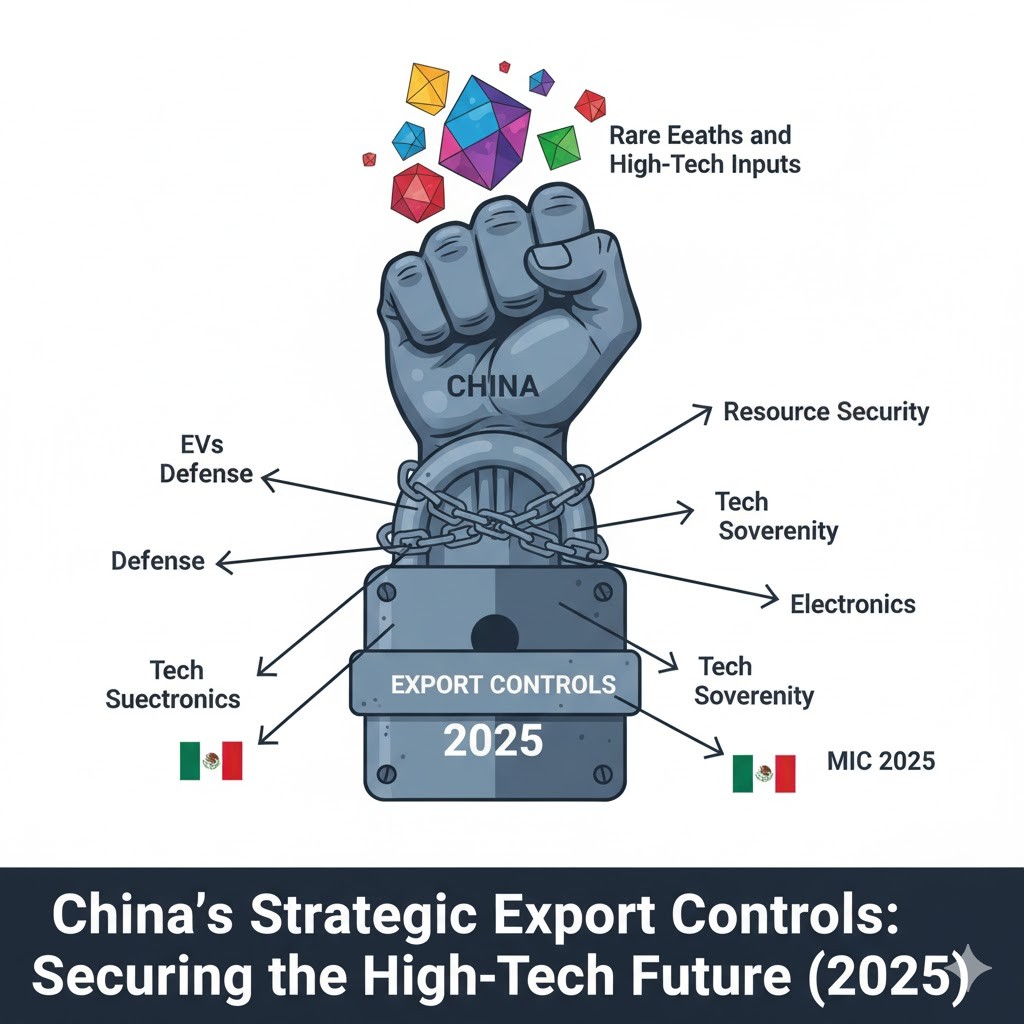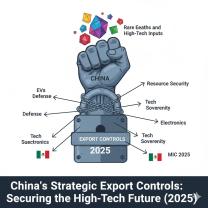China Export Tariffs 2025 Policy Changes: A Comprehensive Guide for Global Exporters
Introduction
Export tariffs, levies imposed by a country on goods leaving its borders, are a powerful and strategic tool in global economic management. Historically, they have been used to manage trade flows, ensuring domestic supply of critical resources; to protect domestic industries, by keeping raw materials prices low for local manufacturers; and to influence global market dynamics by leveraging a dominant position in the supply of specific goods. In the complex world of international commerce, a change in one nation's tariff policy can send ripples across every continent.
China, as the world's largest exporter, has always had its trade policy scrutinized, and the 2025 export tariff adjustments mark a critical juncture. These shifts are not merely bureaucratic tweaks; they signal a deep reorientation of China's economic and geopolitical strategy. The changes have the potential to significantly raise costs for foreign buyers, accelerate the decoupling of global supply chains, and redefine China's international trade competitiveness. Exporters around the world—from multinational corporations to specialized SMEs—must rapidly understand and adapt to this evolving landscape.
This article provides a comprehensive overview of China's latest policy changes, identifying the most affected goods, dissecting the economic and geopolitical motivations behind the adjustments, and outlining actionable strategies for exporters to maintain market access and profitability in the face of new trade barriers. Proactive adaptation is no longer optional; it is the fundamental requirement for sustaining global business operations in the current climate.
What Are the Latest 2025 Changes in China’s Export Tariff Policy?
China’s 2025 export tariff policy adjustments are characterized by a clear strategic emphasis on controlling national resources and leveraging dominance in high-tech supply chains, often in direct response to escalating global trade conflicts, particularly with the United States.
Specific Modifications and Official Statements
The primary modifications in 2025 focus not just on tariffs (duties paid at the point of exit) but also on export controls and licensing requirements, which act as de facto non-tariff barriers:
Rare Earth Metals and Permanent Magnets: The most significant adjustment comes via the Ministry of Commerce's Announcement No. 61 of 2025, which implements the strictest export controls to date on rare earth elements and permanent magnets.
These controls significantly expand the licensing framework: New Licensing Requirement: Foreign firms must obtain Chinese government approval to export magnets containing even trace amounts (
>0.1%) of Chinese-origin rare earth materials, or those produced using Chinese processing technology. Defense Sector Exclusion: Starting December 1, 2025, companies affiliated with foreign militaries (including the U.S. defense sector) are largely denied export licenses, effectively preventing Chinese-origin rare earths from contributing to foreign defense supply chains.
Semiconductor Materials and High-Tech Know-How: Export license applications for rare earth materials used in highly advanced technologies, such as sub-14-nanometer semiconductors and next-generation memory chips, are now subject to rigorous, case-by-case review by central authorities.
Furthermore, restrictions build upon the 2023 ban on rare earth processing technology exports by barring Chinese nationals from supporting overseas projects involving rare earth extraction or processing unless they obtain explicit authorization.
Trends: Tightening Controls on Strategic Goods
The overarching trend in the 2025 policy is a strategic tightening on critical, high-value, and sensitive exports while tariffs on other sectors may remain stable or be adjusted for trade diplomacy purposes. This shift is a move away from purely revenue-generating export tariffs and toward using export controls as a powerful tool of economic leverage and national security:
Tightening on High-Tech/Critical Minerals: The new rules solidify control over the entire rare earth value chain—from mining expertise to the final magnet product—ensuring China dictates who, where, and for what purpose these materials are used globally.
Targeting Know-How: The control over the movement of Chinese expertise and technology acts as an "intangible export control," aiming to prevent other nations from quickly building up their own domestic processing capabilities, thus preserving China's global dominance.
Which Goods Are Subject to New Export Tariffs and Controls in China?
While China's standard export tariff schedule is vast, the critical 2025 policy adjustments focus on a narrow but highly strategic range of goods. These goods are targeted either to ensure domestic supply or to maximize China's geopolitical leverage.
| Product Category | Specific Goods/Examples | 2025 Policy Action | Rationale |
| Critical Minerals | Rare Earth Elements (e.g., Neodymium, Dysprosium), Permanent Magnets | New, rigorous Export Licensing/Controls (Announcement No. 61) | Leverage & Security: Restrict supply to foreign defense sectors; maintain control over global magnet/EV/wind power supply chains. |
| High-End Technology | Sub-14nm Semiconductor Materials, Next-Gen Memory Chip Components | Case-by-Case Review for export licenses | Technological Dominance: Slow the development of foreign high-end chip and AI industries; protect proprietary manufacturing processes. |
| Processing Technology | Rare Earth Separation/Refining Know-How, Magnet Manufacturing Tech | Ban on Outflow of Expertise (via restrictions on personnel support) | Preserve Monopoly: Prevent other nations from replicating China's highly efficient, proprietary processing technology. |
| Other Strategic Raw Materials | Potential future targeting for new tariffs: Gallium, Germanium, Graphite precursors | Ongoing monitoring for inclusion in official export tariff/control lists | Resource Security: Ensure stable domestic supply for local manufacturing before allowing global export. |
The rationale behind targeting these categories is clear:
Strategic Security: Rare earths are essential for advanced military hardware (missiles, jets), electric vehicles (EVs), and wind turbines.
Restricting their export, particularly to foreign military supply chains, is a powerful geopolitical move. Value-Chain Capture: By limiting the export of high-purity rare earth compounds and encouraging the export of finished magnets or products that contain the rare earths, China pushes for higher-value-added production to remain domestic.
Retaliation/Leverage: These controls serve as a direct counter-punch to U.S. export restrictions on U.S.-made semiconductor equipment and technology to China.
How Do Export Tariffs Affect China’s Global Competitiveness?
China's use of export tariffs and controls creates a complex duality for its global competitiveness: increased costs for foreign buyers in the short term, juxtaposed with maintained strategic advantage in the long term.
Short-Term Impacts: The Sourcing Shift
Increased Costs for Foreign Buyers: For goods subject to higher de facto tariffs (via licensing costs, delays, and complexity), foreign buyers face higher input costs. This directly hits downstream industries globally, such as electronics, automotive, and defense.
Accelerated Sourcing Shift ('China+1'): The instability and unpredictability created by the new controls accelerate the existing trend of supply chain diversification. Foreign manufacturers are driven to find alternative, reliable suppliers in countries like Vietnam, India, Mexico, and Thailand to reduce reliance on single-source, high-risk Chinese supply.
This directly impacts China’s position as the undisputed global factory. Market Price Influence: The restrictions on rare earths immediately grant China the ability to influence global commodity pricing.
However, if buyers aggressively seek alternatives, this leverage diminishes over the long term.
Long-Term Effects: Strategic Control and Domestic Advantage
Maintaining Control over Strategic Goods: By regulating the outflow of rare earth materials and related technology, China ensures its domestic manufacturers have first and cheaper access to critical inputs.
This protects its own high-tech ambitions, such as those laid out in the Made in China 2025 initiative. Encouraging Local Innovation: The policy incentivizes Chinese companies to innovate in areas like rare-earth-free magnets or alternative material technologies, securing a path to self-sufficiency and reducing vulnerability to external demand shifts.
Leverage in Diplomacy: The existence of these export controls is a standing source of leverage in any major trade or geopolitical negotiation with the U.S. and its allies.
China uses this control as a bargaining chip to push for the rollback of import tariffs or technology restrictions imposed by its trading partners.
Case Study: Previous Rare Earth Curbs (2010s)Following a brief ban on rare earth exports in the early 2010s, global prices spiked, triggering massive international investment in non-Chinese rare earth mining and processing (e.g., in Australia and the U.S.). While China quickly eased the restrictions, the incident demonstrated that weaponizing these exports leads to long-term global investment in diversification, ultimately eroding China's monopoly over time, even if it provides significant short-term leverage.
What Are the Economic Goals Behind China’s Tariff Adjustments?
China's 2025 tariff and export control adjustments are deeply rooted in a blend of immediate economic objectives and long-term national strategic priorities, far surpassing simple trade balancing.
Core Economic Objectives
| Objective | Policy Alignment | Impact |
| Resource Control & Retention | Tightening export licenses on strategic minerals (Rare Earths, precursors) | Ensures ample and affordable domestic supply for Chinese high-tech manufacturers (EVs, wind power, defense). |
| High-Value Production Focus | Restricting raw material export while encouraging finished goods export (e.g., magnets) | Pushes Chinese industry up the value chain, shifting from exporting basic materials to complex, high-profit components. |
| Technological Security | Barring the outflow of intellectual property and technical expertise | Protects Chinese-developed processing technologies, preventing competitors from closing the technology gap quickly. |
| Trade Diplomacy Leverage | Imposing controls/tariffs in response to foreign trade actions (e.g., U.S. import tariffs) | Creates negotiating chips to demand the rollback of foreign restrictions (e.g., Entity List removals, tariff reductions). |
Alignment with Broader National Strategy
The 2025 policy changes are a direct implementation of the Made in China 2025 (MIC 2025) and broader Dual Circulation strategies:
MIC 2025: The goal of achieving self-sufficiency and global dominance in ten key high-tech sectors—including next-generation IT, robotics, and new energy vehicles—requires secure and cheap access to critical inputs like rare earths. Export controls lock in this advantage.
Supply-Chain Security (Dual Circulation): By emphasizing resource control and encouraging the use of domestic high-tech inputs, China strengthens the "internal circulation" of its economy. This reduces external dependence on imports for critical technology and makes its export-oriented "external circulation" less vulnerable to geopolitical shocks.
In essence, the tariffs and controls are a strategic defense mechanism, designed to insulate China’s industrial policy from foreign pressure while simultaneously creating leverage in global trade diplomacy.
How Should Exporters Adapt to China’s New Tariff Rules?
For global businesses that rely on Chinese goods, the unpredictable nature of the 2025 policy requires an immediate and decisive shift from reactive management to proactive strategic adaptation.
Actionable Strategies for Exporters
| Strategy | Description | Practical Example |
| Supply Chain Optimization & 'China+N' | Implement a 'China+1' or 'China+N' strategy. Diversify sourcing and manufacturing to alternative, lower-risk countries (e.g., Vietnam, Mexico, India) for tariff-sensitive goods. | An electronics company shifts the final assembly of specific components (which use rare earth magnets) from China to Mexico to avoid the risk of export delays/licenses. |
| Pricing Model Adjustment | Recalibrate contract pricing to include a tariff-risk buffer. Review Incoterms (e.g., shift from FOB to DDP) to clearly allocate tariff risk between buyer and seller. | A chemical importer negotiates a new contract that includes a formula allowing for a pre-agreed price adjustment if the Chinese export tariff/fee rises above a specific threshold. |
| Utilize Government Guidance/Incentives | Proactively engage with Chinese trade officials and consultancies to understand the specific criteria for license applications and utilize any available exemptions or refunds. | An exporter of strategic materials applies for an Authorized Economic Operator (AEO) status in China to secure faster customs clearance and potentially better tariff treatment. |
| Tariff Engineering | Where possible, redesign products to fall under a lower-tariff Harmonized System (HS) code classification or to use non-controlled/non-Chinese materials. | A lighting manufacturer redesigns fixtures to use aluminum instead of copper (or other potentially targeted metals) to mitigate future tariff risk. |
Risk Management Tools
Contractual Hedging: Include explicit clauses in supply contracts that define responsibility and remedy for unexpected tariff/export control imposition. Force Majeure clauses should specifically address geopolitical policy shifts.
Inventory Buffering: Maintain higher-than-usual inventory levels for products reliant on newly controlled Chinese inputs (e.g., rare earth components) to hedge against sudden supply disruptions or licensing delays.
Cross-Functional Teamwork: Establish a dedicated internal task force comprising trade compliance, tax/finance, and supply chain personnel to monitor policy changes daily and ensure all intercompany transfer pricing is aligned with customs valuation rules.
FAQ Section
Which industries are most affected by China’s 2025 export tariffs/controls?The most strategically affected industries are Defense, Electric Vehicles (EVs), Wind Energy, and Advanced Electronics (Semiconductors), due to their heavy reliance on China’s controlled rare earth metals and high-end processing technology.
Can exporters pass tariff costs to international buyers?Yes, but competitiveness suffers. Chinese exporters often attempt to pass costs, but high tariffs often lead foreign buyers to quickly seek alternative suppliers (e.g., in Vietnam or India) or demand that the Chinese exporter absorb the cost to maintain the contract.
How often does China adjust export tariffs?China's official tariff schedules (HTS codes) are reviewed annually, but export controls and ad-hoc trade policy adjustments, especially those relating to strategic minerals or technology, can be enacted with very short notice throughout the year, as demonstrated by the rapid rare earth controls in 2025.
Are certain raw materials more strategically targeted than manufactured goods?Yes. China’s strategy is increasingly focused on controlling upstream raw materials and processing technology (like rare earths and their separation techniques) to ensure domestic industry receives the key inputs, which in turn gives China a dominant position in the global downstream manufactured goods (like EV motors and high-performance magnets).
What government resources help exporters manage tariff changes?Exporters should consult their national customs agency websites, foreign trade development agencies (e.g., the U.S. Commercial Service, EU Directorate-General for Trade), and professional trade compliance/tax advisories. Within China, official statements from the Ministry of Commerce (MOFCOM) and the General Administration of Customs (GACC) are the primary sources of authoritative policy.
Conclusion
China’s 2025 export tariff adjustments, characterized by the aggressive imposition of strategic export controls on critical goods like rare earth metals and high-tech expertise, signify a deepening alignment of its trade policy with its national security and technological self-sufficiency goals.
For global exporters, the necessity of strategic adaptation cannot be overstated. Success in this evolving trade landscape hinges on the swift implementation of resilient supply chains (i.e., 'China+N'), the strategic adjustment of pricing and contractual risk, and the proactive engagement with trade policies.
Looking ahead, businesses that prioritize policy monitoring and aggressively pursue supply chain diversification will be the most successful. The global trade environment is no longer stable; it is now a landscape of geopolitical risk and leveraged commodities.



EV_Manufacturer_HQ
on October 13, 2025As an EV maker, the stability of rare earth permanent magnets is paramount. This policy directly threatens our production targets and forces a faster pivot to non-rare earth motor technologies.